社会科学问题研究的计算实践——5、匹配市场(计算实践:实现匹配市场算法)
学习资源来自,一个哲学学生的计算机作业 (karenlyu21.github.io)
1、背景问题
1.1、偏好卖家图
亚当斯密提出,市场经济就像有一个“无形之手”,把各方都安排妥当。本节课我们的任务就是把这一理论模型化。
考虑如下一个情境:要把一堆物品分配给一群人,不同人的偏好可能发生冲突,如何分配是最优的?为了简化问题,我们考虑一个更具体的情境:把n件物品一一分配给n个人。
我们把每个人对每个物品的偏好,抽象为一个出价(估值)矩阵,买家i对物品j的出价vij越高,意味着买家i越想要物品j。此外,每种物品的价格也各不相同,这构成了一个价格矩阵,物品j的价格用pj表示。对于每一买家i,我们可以找出他最想要的物品j。具体地,我们要找出vij−pj的最大值,因为这个差价定义了买家i能从物品j上获得的效用。
为了更形象地表示这一市场里每个人的的偏好情况,我们用一个二部图表示买家和物品,下图中左侧节点为物品(或“卖家”),右侧节点为买家。对于每一买家i,在ta与ta最想要的物品j之间做边(对应最大差价)。这样做出的图,就定义了体现买方喜好的一种二部图,称为“偏好卖家图”。
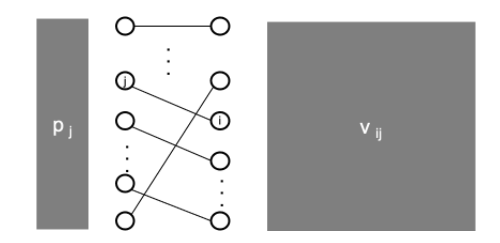
如果这一二部图里,每个买家的偏好恰好互不冲突,这一市场就存在“合理分配”。
1.2、以“物以稀为贵”促成“合理分配”
对于一个特定的市场,亦即,对于特定的价格矩阵和特定的出价矩阵,不一定存在“合理分配”。为了解决这一问题,我们需要引入一个新的理论假设,“物以稀为贵”:如果买家的一个子集S所表达的偏好物品子集N(S)比S小,说明N(S)中的物品没法在S中无冲突地安排,意味着“稀有了”“紧俏了”,于是应该加价。这样的S称为“受限组”。
以“物以稀为贵”促成“合理匹配”的全过程就是,对全市场里所有紧俏的物品如此操作,不断迭代,直到这一市场存在“合理分配”。
我们设所有物品的初始价格为0,实现合理分配时的最终价格,由偏好矩阵决定,越受欢迎的物品价格越高。
以下图为例,a、b、c的初始价格都为0。但此时,大家都想要物品a。也就是说,存在买家受限组S={x,y,z},此时的受限组邻居N(S)={a}。
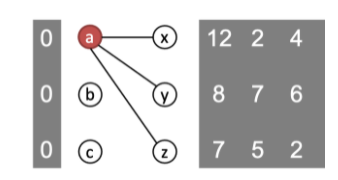
物品a紧俏,我们就把pa从0提高到1。提价后,重新画偏好卖家图如下:
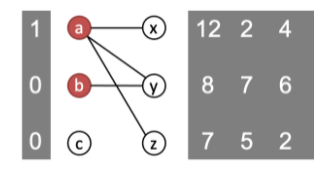
迭代操作,直到该市场存在合理分配,没有买家受限。
这一市场在价格向量为(3,1,0)时出现合理分配,我们把(3,1,0)称为清仓价格。
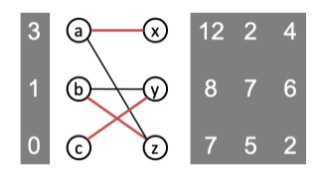
p.s. 当一个情境存在多个受限组时,选择哪一个受限组进行操作可能会影响最终的清仓价格,这意味着清仓价格不唯一。
1.3、对匹配算法的反思
我们可以证明,如此找出的合理分配,实现了社会福利的最大化。
给定清仓价格(p)和估值矩阵(V),每个买家从买到的物品身上获得的效用(估值与价格的差值)的总和差价max(∑差价)是最大的,这一总和可以如此表达:

对于任意一种分配方式,总有:

因此,

给定一组价格,匹配算法取到差价max(∑差价)时,也同时取到了对应估值max(∑对应估值)。
这个算法有更广泛的应用:
- 给定一个n×n的整数矩阵,从中选择n个不同行不同列元素,使得加和最大。
- 每个人给出自己的偏好序列,我们也可以依据这一偏好人为地赋值,从而使用这一算法进行物品分配。
另一个问题是,为什么提价时我们以1为单位呢?这是因为估值矩阵里的价差最小为1。提价+1,才能把价差1的偏好区别体现在市场分配上。如果提价时+2,可能导致一下子提价太多,大家都不想要这个商品了。
此外,匹配算法过程总能结束,我们可以给出一个数学证明。
定义一个势能函数:

在匹配算法运行过程中,P逐渐减小:每一次进行操作时,+1一致地发生在买方受限组S关注的所有卖方N(S)上;由于S严格大于N(S) ,P每次增|N(S)|,至少减|S|,即P单调递减。
但P又不能无限制地减下去,我们可以证明P≥0恒成立:
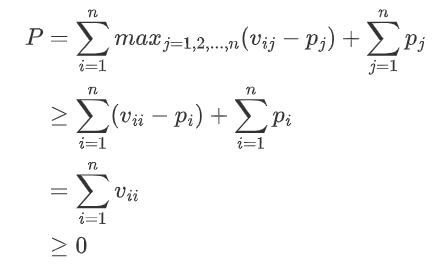
P的减小总有个头,所以匹配算法一定能结束。
总之,我们把经济学中的经典概念,例如理性人、价格、供需关系、物以稀为贵、均衡、社会最优,做出了生动的表达,使用的是简单图论语言和计算过程描述,例如偏好卖家图、受限组、迭代调整价格、结束条件。
2、计算实践:实现匹配市场算法
2.1、作业描述与算法思路
为了把这一模型放在一个更具体的场景中,李老师给全班的同学发放问卷,让班上的11个同学给出对11本书的出价,得到具体的出价矩阵如下:
| 序号 | 西方哲学史 | 中国历代政治得失 | 尤利西斯 | 致命的自负 | 车浩的刑法题 | 深度学习 | 时间序列分析 | 期权、期货及其他衍生产品 | 红书 | 历史的逻辑 | 海德格尔哲学概论 |
|---|---|---|---|---|---|---|---|---|---|---|---|
| 1 | 0 | 0 | 10 | 5 | 0 | 25 | 20 | 10 | 0 | 0 | 0 |
| 2 | 5 | 10 | 1 | 1 | 0 | 40 | 4 | 0 | 55 | 10 | 30 |
| 3 | 0 | 0 | 0 | 10 | 0 | 0 | 0 | 5 | 0 | 5 | 0 |
| 4 | 20 | 0 | 60 | 20 | 0 | 60 | 0 | 0 | 0 | 30 | 10 |
| 5 | 40 | 10 | 30 | 20 | 5 | 25 | 40 | 0 | 35 | 30 | 13 |
| 6 | 10 | 10 | 0 | 10 | 20 | 0 | 20 | 0 | 0 | 20 | 10 |
| 7 | 55 | 30 | 50 | 10 | 0 | 50 | 50 | 0 | 80 | 20 | 30 |
| 8 | 0 | 0 | 0 | 0 | 0 | 30 | 30 | 70 | 0 | 0 | 0 |
| 9 | 0 | 20 | 10 | 15 | 30 | 15 | 0 | 0 | 5 | 5 | 0 |
| 10 | 10 | 0 | 0 | 35 | 0 | 10 | 55 | 45 | 0 | 0 | 0 |
| 11 | 20 | 10 | 20 | 0 | 0 | 10 | 0 | 0 | 0 | 10 | 20 |
本次作业就是找出以上市场的最优匹配。我们输入以上估值矩阵,输出一组清仓价格、对应的偏好卖家图(二部图)上的一个完整匹配、对应的社会最优(值)。
根据前文,先设所有书的初始价格为零,根据估值矩阵和价格矩阵确定偏好卖家图,判断合理匹配是否存在,如果存在就输出合理匹配,不存在就找出受限组邻居(大家都想要的物品),对受限者邻居提高一个单位的价格。迭代运行以上算法,直到实现完整匹配。
编程中存在几个难点:
- 如何判断当前市场中是否存在完整匹配?如果不存在,如何返回一个受限组和其对应的受限组邻居?这一部分不在我们的作业要求中,李老师给了我们一个函数
perfect_match供调用。 - 如何根据估值矩阵或价格矩阵生成偏好卖家图?首先要找出买家i最想要哪个物品。我们遍历所有物品,计算买家i的估值和价格之差,找出差价最大者j即可。而至于二部图的数学表示,以如下的矩阵(记为A)为例:
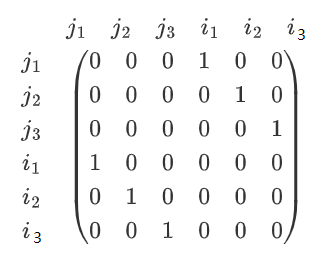
i1想要j1(A[i1] [j1]=1,A[j1] [i1]=1),i2想要j2,i3想要j3。二部图矩阵的左上和右下总为0,因为一部内部没有边;而左下和右上表示不同部的两个元素之间的关系,可以是0,也可以是1。因此,二部图矩阵可以表示为以下一般形式:

2.2、编程实现与要点说明
李老师提供了perfect_match函数:输入表示偏好卖家图的二部图,如果存在完整匹配,返回True和完整匹配边集{ (i,matched[i]) for i in range(n) };如果不存在,返回False和一个受限组邻居{matched[n] for n in bfs_queue if n != i}。
"""
程序提供perfect_match函数,该函数接收一个2n个节点二部图的邻接矩阵,前n个节点可认为二部图左部,后n个节点为右部。
若存在完美匹配,函数返回真及一个完美匹配的边集合,否则返回假并给出右部节点的一个受限集关联的左部邻居节点集合。
基本思路为对左部未匹配节点作交替BFS,找增广路径,详见教材10.6或"匈牙利算法"。
"""
def perfect_match(matrix):
node_num = len(matrix)
node_left = node_num >> 1
# 邻接矩阵转化为邻接表,对稀疏图可提高下面循环的效率
graph = [{i for i in range(node_num) if matrix[j][i] == 1} for j in range(node_num)]
checked = [-1] * node_num # 记录某节点i是否已在checked[i]节点为根的先宽搜索树中
prev = [-1] * node_num # 记录交替路径中某右部节点的上一个右部节点,左部节点已被matched记录
matched = [-1] * node_num # 记录某节点匹配的节点
for i in range(node_left, node_num):
if matched[i] != -1: # i应是某尚未匹配的右部节点
continue
# 先宽搜索队列只记录右部节点,这些节点是左部节点通过已有匹配边一一对应来的
bfs_queue = [i]
pos = 0 # 记录遍历队列的当前位置
flag = False # 一次搜索找到一条增广路径即完成
prev[i] = -1 # i记录为路径起点
while pos < len(bfs_queue) and not flag:
node = bfs_queue[pos]
# node是右部节点,j是与之相邻的左部节点
for j in graph[node]:
if checked[j] == i:
continue
checked[j] = i
# 将j匹配的右部节点加入队列继续搜索
if matched[j] > -1:
bfs_queue.append(matched[j])
prev[matched[j]] = node
# j没有匹配的右部节点说明找到增广路径
else:
flag = True
t1, t2 = node, j
while t1 != -1:
t3 = matched[t1]
matched[t1] = t2
matched[t2] = t1
t1 = prev[t1]
t2 = t3
if flag:
break
pos += 1
# 该右部节点无法匹配说明不存在完美匹配,此时搜索队列即组成一个受限组。
# 因为i未能匹配说明前面没有从i出发找到增广路径,即i的搜索树中左部节点总是通过已有匹配一一对应到其他右部节点,
# 因此这些右部节点和i恰比它们的邻居左部节点多1
if matched[i] == -1:
return False, {matched[n] for n in bfs_queue if n != i}
return True, {(i, matched[i]) for i in range(node_left)}
我们的任务,就是要根据出价矩阵和价格矩阵生成偏好卖家图,调用perfect_match函数,对受限组邻居进行加价;迭代这一过程,直到出现完整匹配。
第一步仍然是读取文件中的出价矩阵,存储在numpy 2d-array bids里,数据见上。初始价格为[0, 0, 0, 0, 0, 0, 0, 0, 0, 0, 0]。
出价矩阵为:
0 0 10 5 0 25 20 10 0 0 0
5 10 1 1 0 40 4 0 55 10 30
0 0 0 10 0 0 0 5 0 5 0
20 0 60 20 0 60 0 0 0 30 10
40 10 30 20 5 25 40 0 35 30 13
10 10 0 10 20 0 20 0 0 20 10
55 30 50 10 0 50 50 0 80 20 30
0 0 0 0 0 30 30 70 0 0 0
0 20 10 15 30 15 0 0 5 5 0
10 0 0 35 0 10 55 45 0 0 0
20 10 20 0 0 10 0 0 0 10 20
def arrayGen(filename):
f = open(filename, 'r')
r_list = f.readlines() # 返回包含size行的列表, size 未指定则返回全部行
f.close()
A = []
for line in r_list:
if line == '\n':
continue
line = line.strip('\n')
line = line.strip() # 用于移除字符串头尾指定的字符(默认为空格或换行符)或字符序列,不能删除中间字符
row_list = line.split() # 通过指定分隔符对字符串进行切片
for k in range(len(row_list)):
row_list[k] = row_list[k].strip()
row_list[k] = int(row_list[k])
A.append(row_list)
n = len(A[0])
A = np.array(A)
return A, n
filename = input('请输入出价矩阵文件名:')
bids, n = arrayGen(filename)
说明:以下原作者只给出了部分代码,所以仅供参考。
根据出价矩阵和价格矩阵,我先生成一个表示偏好卖家图的二部图。
round = 0
while True:
round += 1
print('- - - - - - - - - - - - - - - - - - round %i - - - - - - - - - - - - - - - - - -' % round)
market = np.zeros((items + buyers, items + buyers))
具体地,对于买家i,我找出差价最大的物品,存储在bid_item这一列表里(可能有多个)。
for i in range(buyers):
diff_max = bids[i][0] - prices[0]
bid_item = [0]
for j in range(1, items):
# the starting-point of comparison: the first item
bid = bids[i][j]
diff = bid - prices[j]
# compare to get the most wanted item
if diff > diff_max:
diff_max = diff
bid_item = [j]
elif diff == diff_max:
bid_item.append(j)
market二部图里,前items个编码表示物品,剩下的编码表示买家。买家i想要物品k在market二部图里就表示为
for k in bid_item:
market[items + i][k] = 1
market[k][items + i] = 1
生成二部图market后,我就可以调用perfect_match函数。当市场不存在完整匹配时,我就对perfect_match返回的受限组邻居nb_set进行提价。
if perfect_match(market)[0]:
...
break
print('未能清仓。Prices for the next round:', end = ' ')
nb_set = perfect_match(market)[1]
for i in nb_set:
prices[i] += 1
print(prices)
第一轮的运行结果如下:
>>> - - - - - - - - - - - - - - - - - - round 1 - - - - - - - - - - - - - - - - - -
>>> 未能清仓。Prices for the next round: [0. 0. 0. 0. 0. 0. 0. 0. 1. 0. 0.]
迭代运行多轮,直到perfect_match(market)[0] = True,实现清仓。输出清仓价格:
if perfect_match(market)[0]: # succeed clearing
print('清仓价格:', end = '')
print(prices)
>>> 清仓价格:[10. 0. 10. 0. 0. 20. 15. 5. 35. 0. 10.]
接着就是输出匹配结果、计算社会福利。计算社会福利时,我需要把每个人为ta买到的商品的估值final_price加总。
wellBeing = 0
bought_dict = {}
for item in perfect_match(market)[1]:
bought = item[0]
buyer = item[1] - buyers
final_bid = bids[buyer][bought]
final_price = prices[bought]
final_diff = final_bid - final_price
bought_dict[buyer] = [bought, final_price, final_diff]
wellBeing += final_bid
print('右边买家%i与左边卖家%i匹配,他该支付%i,得最大差价%i。' \
% (buyer, bought, final_price, final_diff))
print('优化的社会福利为:', end = '')
print(wellBeing)
具体结果如下:
>>> 右边买家10与左边卖家1匹配,他该支付0,得最大差价10。
>>> 右边买家8与左边卖家4匹配,他该支付0,得最大差价30。
>>> 右边买家4与左边卖家0匹配,他该支付10,得最大差价30。
>>> 右边买家2与左边卖家3匹配,他该支付0,得最大差价10。
>>> 右边买家0与左边卖家5匹配,他该支付20,得最大差价5。
>>> 右边买家1与左边卖家10匹配,他该支付10,得最大差价20。
>>> 右边买家7与左边卖家7匹配,他该支付5,得最大差价65。
>>> 右边买家9与左边卖家6匹配,他该支付15,得最大差价40。
>>> 右边买家5与左边卖家9匹配,他该支付0,得最大差价20。
>>> 右边买家6与左边卖家8匹配,他该支付35,得最大差价45。
>>> 右边买家3与左边卖家2匹配,他该支付10,得最大差价50。
>>> 优化的社会福利为:430
另外,我还提供了查询每个人应该买什么书的代码:
if fname.endswith('.csv'): # This part is needed only when the data file is a csv file (which has recorded students' preferences for books)
while True:
me = input('Which one is you? (input integers from 0 to 10)\nTo know which one Wenhui needs to buy, input 10.\ninput here: ')
try:
me = int(me)
if me in range(11):
break
except:
pass
print('Wrong input.', end = ' ')
bookBought = book_list[bought_dict[me][0]]
print('I need to buy %s at the cost of %i, getting the largest difference of %i.' % (bookBought, bought_dict[me][1], bought_dict[me][2]))
输入我对应的编码,可以得到我应该买《中国历代政治得失》:
>>> Which one is you? (input integers from 0 to 10)
>>> To know which one Wenhui needs to buy, input 10.
>>> input here: 10
>>> I need to buy 《中国历代政治得失》钱穆,三联书店 at the cost of 0, getting the largest difference of 10.
3、完整代码
匹配市场
import numpy as np
import os
"""
程序提供perfect_match函数,该函数接收一个2n个节点二部图的邻接矩阵,前n个节点可认为二部图左部,后n个节点为右部。
若存在完美匹配,函数返回真及一个完美匹配的边集合,否则返回假并给出右部节点的一个受限集关联的左部邻居节点集合。
基本思路为对左部未匹配节点作交替BFS,找增广路径,详见教材10.6或"匈牙利算法"。
"""
def perfect_match(matrix):
node_num = len(matrix)
node_left = node_num >> 1
# 邻接矩阵转化为邻接表,对稀疏图可提高下面循环的效率
graph = [{i for i in range(node_num) if matrix[j][i] == 1} for j in range(node_num)]
checked = [-1] * node_num # 记录某节点i是否已在checked[i]节点为根的先宽搜索树中
prev = [-1] * node_num # 记录交替路径中某右部节点的上一个右部节点,左部节点已被matched记录
matched = [-1] * node_num # 记录某节点匹配的节点
for i in range(node_left, node_num):
if matched[i] != -1: # i应是某尚未匹配的右部节点
continue
# 先宽搜索队列只记录右部节点,这些节点是左部节点通过已有匹配边一一对应来的
bfs_queue = [i]
pos = 0 # 记录遍历队列的当前位置
flag = False # 一次搜索找到一条增广路径即完成
prev[i] = -1 # i记录为路径起点
while pos < len(bfs_queue) and not flag:
node = bfs_queue[pos]
# node是右部节点,j是与之相邻的左部节点
for j in graph[node]:
if checked[j] == i:
continue
checked[j] = i
# 将j匹配的右部节点加入队列继续搜索
if matched[j] > -1:
bfs_queue.append(matched[j])
prev[matched[j]] = node
# j没有匹配的右部节点说明找到增广路径
else:
flag = True
t1, t2 = node, j
while t1 != -1:
t3 = matched[t1]
matched[t1] = t2
matched[t2] = t1
t1 = prev[t1]
t2 = t3
if flag:
break
pos += 1
# 该右部节点无法匹配说明不存在完美匹配,此时搜索队列即组成一个受限组。
# 因为i未能匹配说明前面没有从i出发找到增广路径,即i的搜索树中左部节点总是通过已有匹配一一对应到其他右部节点,
# 因此这些右部节点和i恰比它们的邻居左部节点多1
if matched[i] == -1:
return False, {matched[n] for n in bfs_queue if n != i}
return True, {(i, matched[i]) for i in range(node_left)}
def arrayGen(filename): # derive the array from the input file
f = open(filename, 'r', encoding='utf-8')
r_list = f.readlines()
f.close()
bids = []
book_list = []
for line in r_list:
if line == '\n': # remove blank lines
continue
# convert a line to elements within
line = line.strip('\n')
line = line.strip()
if filename.endswith('.txt'):
row_list = line.split() # txt: split when whitespace is encounteded
else:
row_list = line.split(',') # csv: split when ',' is encounteded
del row_list[0] # delete the column with the sequence number
if line in r_list[0]: # the first line of csv file should be removed
book_list = row_list
continue
# integralization
for k in range(len(row_list)):
row_list[k] = row_list[k].strip()
try:
row_list[k] = int(row_list[k])
except:
row_list[k] = float(row_list[k])
bids.append(row_list)
# the array of bids
bids = np.array(bids)
items = len(bids[0])
buyers = len(bids)
return bids, items, buyers, book_list
# input file
'''
for i in range(2):
try:
fname = input('请输入出价数据文件名(val.txt or prices.csv):')
pathname = os.path.join('./', fname)
bids, items, buyers, book_list = arrayGen(pathname)
except:
print('输入错误。', end='')
fname = None
if fname == None:
print('使用默认文件val.txt')
fname = 'val.txt'
pathname = 'val.txt'
bids, items, buyers, book_list = arrayGen(pathname)
'''
fname = './prices.csv'
pathname = './prices.csv'
bids, items, buyers, book_list = arrayGen(pathname)
print('items: %i, buyers: %i.' % (items, buyers))
print('bids:')
print(bids)
prices = np.zeros(items) # prices set for each item
round = 0
while True:
round += 1
print('- - - - - - - - - - - - - - - - - - round %i - - - - - - - - - - - - - - - - - -' % round)
# market: each person want the item(s) with the max difference between his bid and the set price
market = np.zeros((items + buyers, items + buyers))
for i in range(buyers):
diff_max = bids[i][0] - prices[0]
bid_item = [0]
for j in range(1, items):
# the starting-point of comparison: the first item
bid = bids[i][j]
diff = bid - prices[j]
# compare to get the most wanted item
if diff > diff_max:
diff_max = diff
bid_item = [j]
elif diff == diff_max:
bid_item.append(j)
# the most wanted item(s) is denoted 1
for k in bid_item:
market[items + i][k] = 1
market[k][items + i] = 1
if perfect_match(market)[0]: # succeed clearing
print('清仓价格:', end='')
print(prices)
wellBeing = 0
bought_dict = {}
for item in perfect_match(market)[1]:
bought = item[0]
buyer = item[1] - buyers
final_bid = bids[buyer][bought]
final_price = prices[bought]
final_diff = final_bid - final_price
bought_dict[buyer] = [bought, final_price, final_diff]
wellBeing += final_bid
print('右边买家%i与左边卖家%i匹配,他该支付%i,得最大差价%i。' \
% (buyer, bought, final_price, final_diff))
print('优化的社会福利为:', end='')
print(wellBeing)
# output which person need to buy which book specifically
if fname.endswith('.csv'):
while True:
me = input(
'Which one is you? (input integers from 0 to 10)\nTo know which one WZM needs to buy, input 10.\ninput here: ')
try:
me = int(me)
if me in range(11):
break
except:
pass
print('Wrong input.', end=' ')
bookBought = book_list[bought_dict[me][0]]
print('I need to buy %s at the cost of %i, getting the largest difference of %i.' \
% (bookBought, bought_dict[me][1], bought_dict[me][2]))
break
# Clearance not met
print('未能清仓。Prices for the next round:', end=' ')
# raise the neighbor(s)'s price(s) to 1 point higher
nb_set = perfect_match(market)[1]
for i in nb_set:
prices[i] += 1
print(prices)

 计算实践:实现匹配市场算法
计算实践:实现匹配市场算法

